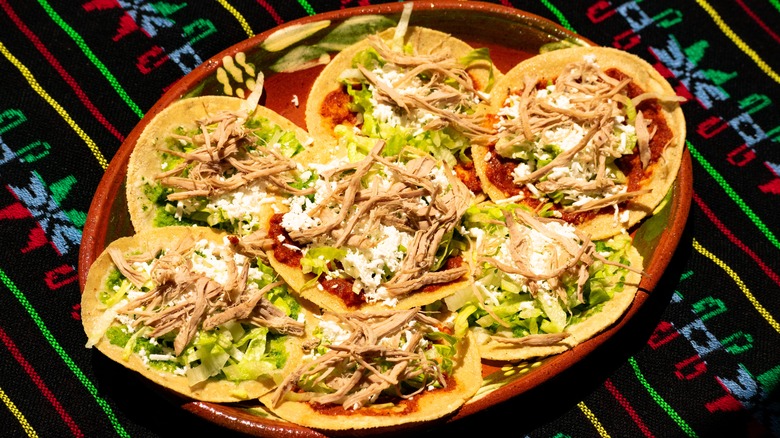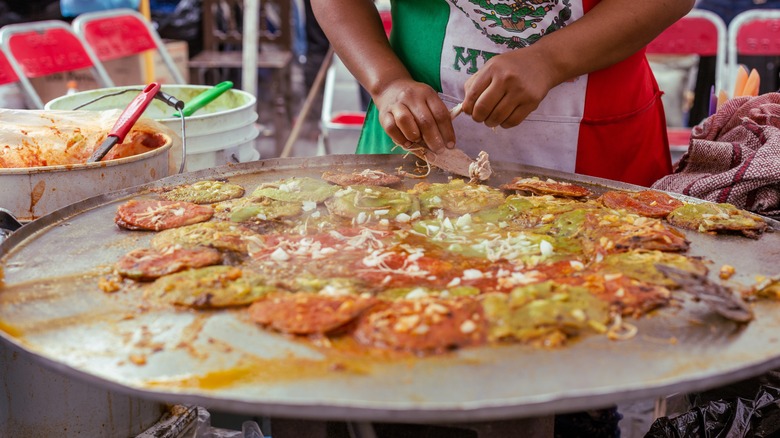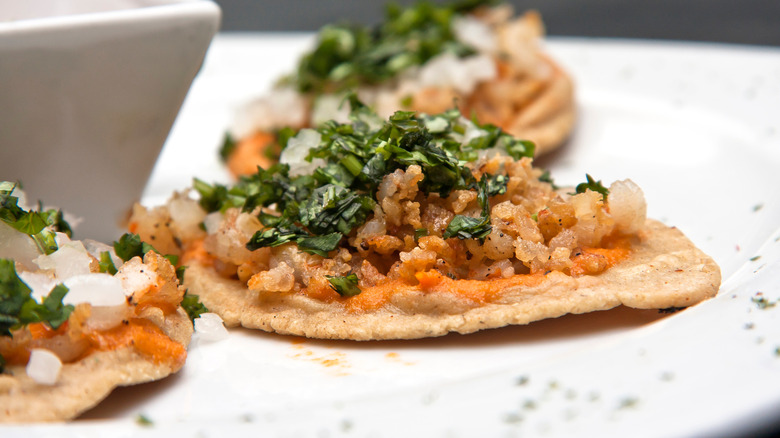What Are Chalupas And How Are They Significant To Cinco De Mayo?
Cinco de Mayo commemorates Mexico's victory over France at the Battle of Puebla in 1862. In the United States, the occasion is often celebrated with pitchers of margaritas and popular Tex-Mex dishes like nachos, enchiladas, and fajitas. However, to honor the day authentically, it would be more appropriate to indulge in traditional dishes popular in Puebla, such as chalupas.
Puebla-style chalupas are quite different from Taco Bell's version of Mexican street food. They are two-bite snacks made from a flatbread-like dough that's deep-fried. While they may resemble tacos and tostadas, the dough is thicker, creating a crunchy and chewy texture. The hot shell is topped with various ingredients like shredded cheese (such as queso fresco), salsa, and lettuce, providing contrasting textures and temperatures for a satisfying mouthfeel — you can't stop at just one.
The dish's name has two possible origins that date back centuries. Some believe chalupas were named after the wooden baskets Spanish settlers in Puebla carried on their heads as they walked to the river to do laundry. Others suggest the name comes from ancient boats used by the Aztec empire, also called chalupas. While both theories could plausibly explain the food's cup-shaped design and its catchy name, the dish's cultural significance is undisputed.
The cultural importance of Puebla's chalupas
Cinco de Mayo is celebrated throughout the U.S. and Mexico, but considering the battle took place in Puebla, the city has a particularly important tie to the holiday. Though colonization left some influences on the state's cuisine and architecture, Puebla's gastronomy, known as "Cocina Poblana," is well-known, making the city a popular culinary destination that continues to thrive.
In fact, in 1987, Puebla was designated as a UNESCO World Heritage site to preserve the city's cultural traditions, and in 2010, traditional Mexican cuisines were awarded UNESCO's Representative List of the Intangible Cultural Heritage. These traditions include Puebla's ancestral culinary techniques, which are still used to prepare the city's most famous dishes, such as mole poblano, chiles en nogada, and chalupas. For generations, unique utensils, farming methods, and cooking practices have been used to prepare the maize for chalupa dough, popular in the region's open-air markets today.
Food stalls are packed with people devouring chalupas and other small dishes called antojitos, "little cravings," before and after meals. Unlike the two other Puebla dishes, which take three to four hours to prepare, chalupas are street food, and can be made relatively quickly. If you live near a Mexican tortilleria, which makes tortillas from scratch, you can buy the dough and easily fry the chalupas at home. Otherwise, find masa harina mix, which only needs water added.
How do chalupas differ from tacos and tostadas?
Chalupas, tostadas, and tacos are some of Mexico's most popular antojitos. Although the dishes start with the same dough, they can be distinguished by their shells. Traditionally, the snacks are prepared with masa harina dough that's flattened using a tortilla press. If you don't have one, a cast-iron pan can be used. Tostadas are pressed the thinnest before deep frying until crispy, like tortilla chips. The flat shell is typically layered with refried beans but can be topped like a pizza with meat, cheese, salsa, and avocado.
When the tortilla is slightly thicker and cooked in a skillet, you get Mexico's most widely recognized antojitos, tacos. Soft tacos are traditionally served with two corn tortillas folded in half to prevent the delicate shell from tearing and depositing the filling on your lap. In the U.S., hard taco shells are popular and commonly made with wheat or corn flour. Tacos are filled with everything: meat, fish, cheese, salsas, and veggies.
Chalupas are a hybrid of the two recipes. The homemade tortilla dough is pressed ¼ inches thick and pricked with a fork to prevent it from puffing up as it fries. The edges naturally curl upward as they fry to create little boat-shaped flatbreads. They are commonly found in Puebla's Almoloya area, simply topped with green and red salsa and white cheese to represent the colors of the Mexican flag.



